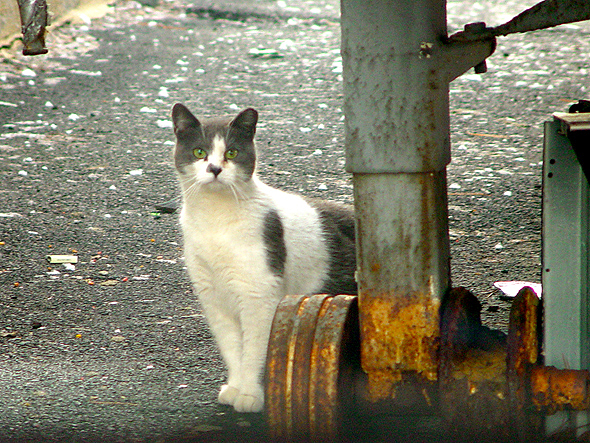
Michael Phillips, president of the Urban Cat League, poked his head out of the small doorway which ran from the basement of the apartment building to the courtyard beyond. He had set a trap there earlier, baited with lumps of soft cat food leading to the pressure plate which would close the door of the trap as soon as his quarry stepped inside. He lowered his head slowly, climbing down the cement stairs and into the basement once more.
“He knows that there’s something off with the trap,” Phillips commented. “He knows that it has something to do with how his friends disappeared.”
With the help of other volunteers, Phillips has been working on trapping all twelve of the feral cats which have made their homes in a courtyard between several high-end apartment buildings on the west side of Central Park; they won’t reveal the exact location out of fear that people will dump their cats there. So far, they’ve succeeded in transferring eleven cats to the large, walk-in pen which they took all summer assembling in the basement of one of the buildings.
Like many other organizations that deal with feral cats in New York City, the Urban Cat League follows the policy of TNR- Trap, Neuter, Return. They use traps to capture cats, take them to a vet to be spayed or neutered and then, after tipping one ear to show other organizations that the cat has already been taken care of, release them back where they found them.
In theory, this policy will cull the cat population as it slowly ages and dies off. It is the policy for the larger colonies the Urban Cat League monitors, one of which, near the Javits Center, numbers more than thirty cats. But the colony found between the apartment buildings presents a special situation. One of the building managers has started to be uncooperative about access and, fearful of being unable to feed the cats during the winter, the organization has instead decided to move them into the basement enclosure, which allows for caged outdoor access as well.
Phillips climbed the cement stairs again, picking up the metal trap and carrying it back inside. He carefully exchanged the globs of cat food on the tray for fish-flavored ones, hoping that the new food would be more successful. “These cats are wild, but they can all live indoors,” Phillips said, pointing out a black cat in a smaller cage that he hadn’t yet transferred to a large enclosure housing the nine other cats. Phillips had caught the cat the other day, and it was comfortably settled in one corner of the cage. “They calm down after they have time to adjust.”
The ten-year-old organization is one of few that doesn’t release all of the cats that they capture back to their respective colonies. Instead, the Urban Cat League, consisting of thirty-five volunteers, prides itself on finding homes for the cats that are either lost pets or are young enough to be socialized.
“Ninety-nine percent of ferals you pick up on the street won’t have anything to do with humans,” said Peggy Imbrie, a stage manager and one of the volunteers for the Urban Cat League. She helps clean up the cats at Pets NYC, a pet store located on Ninth Avenue and 43rd Street, which has collaborated with the Urban Cat League to help facilitate adoptions. At any time, the store may have as many as ten cats or as few as two. “Our happiest and easiest adoptions are when someone reports there’s a new cat at one of the colonies or on the street and she has kittens,” she said.
Kittens are easiest to socialize at six weeks of age, but after eight weeks, it can take months before the cat is comfortable with people. The biggest challenge, though, is that people abandon their cats at various colonies throughout the city.
Gene King, one of the owners of Pets NYC, commented, “One thing people always think is we’re trying to find cats. Three or four times a week, people come in and want to give us their cats.”
The results can be dire. A population of ten can easily grow to a population of seventy or more in only a couple of years if the cats haven’t been neutered. With food handouts from people and a large rat population in New York City, cats can flourish. In addition, Animal Care and Control, a branch that comes under the Health Department, doesn’t have the resources to catch cats on a habitual basis.
“They’re grateful for free labor,” said Phillips, commenting on how Animal Care and Control doesn’t actually seek out feral cat colonies. Instead, they leave it to organizations to implement the TNR method.
With a clang, the sound of the closing trap echoed through the basement. Bringing a white blanket, Phillips quickly climbed the cement stairs into the courtyard. In one corner was a brown tabby, trapped in the metal cage. He carefully lay the blanket over both cat and cage to calm the creature down before picking it up and bringing it inside.
“It’s okay. Are you ready to see your friend now?” he asked the cat as he set him down in his new home.